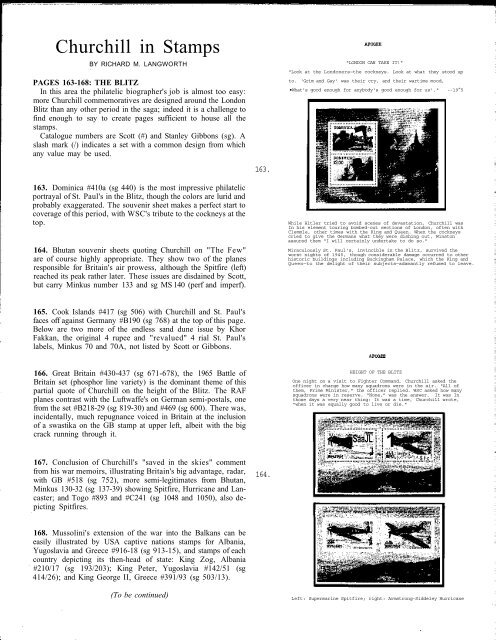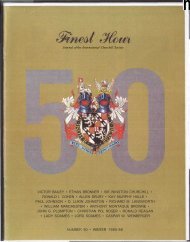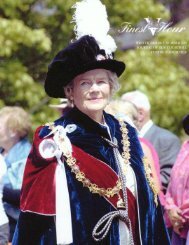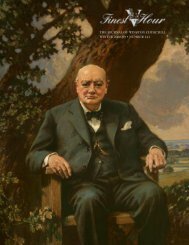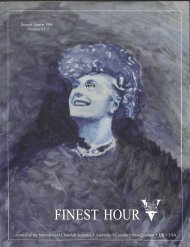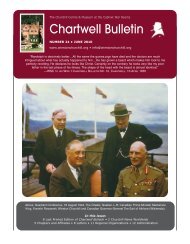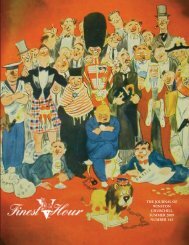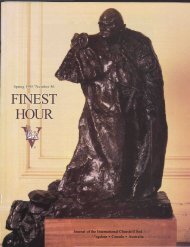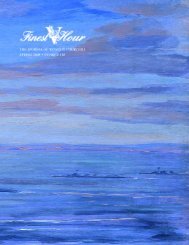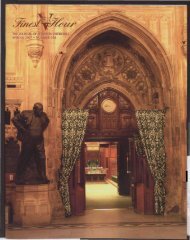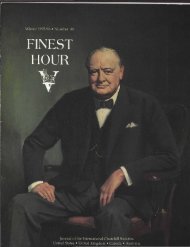international datelines - Winston Churchill
international datelines - Winston Churchill
international datelines - Winston Churchill
You also want an ePaper? Increase the reach of your titles
YUMPU automatically turns print PDFs into web optimized ePapers that Google loves.
<strong>Churchill</strong> in Stamps<br />
BY RICHARD M. LANGWORTH<br />
PAGES 163-168: THE BLITZ<br />
In this area the philatelic biographer's job is almost too easy:<br />
more <strong>Churchill</strong> commemoratives are designed around the London<br />
Blitz than any other period in the saga; indeed it is a challenge to<br />
find enough to say to create pages sufficient to house all the<br />
stamps.<br />
Catalogue numbers are Scott (#) and Stanley Gibbons (sg). A<br />
slash mark (/) indicates a set with a common design from which<br />
any value may be used.<br />
163. Dominica #410a (sg 440) is the most impressive philatelic<br />
portrayal of St. Paul's in the Blitz, though the colors are lurid and<br />
probably exaggerated. The souvenir sheet makes a perfect start to<br />
coverage of this period, with WSC's tribute to the cockneys at the<br />
top.<br />
164. Bhutan souvenir sheets quoting <strong>Churchill</strong> on "The Few"<br />
are of course highly appropriate. They show two of the planes<br />
responsible for Britain's air prowess, although the Spitfire (left)<br />
reached its peak rather later. These issues are disdained by Scott,<br />
but carry Minkus number 133 and sg MS 140 (perf and imperf).<br />
163.<br />
"LONDON CAN TAKE IT!"<br />
"Look at the Londoners—the cockneys. Look at what they stood up<br />
to. 'Grim and Gay' was their cry, and their wartime mood,<br />
•What's good enough for anybody's good enough for us'."<br />
--19^5<br />
While Hitler tried to avoid scenes of devastation, <strong>Churchill</strong> was<br />
In his element touring bombed-out sections of London, often with<br />
Clemmle, other times with the King and Queen. When the cockneys<br />
cried to give the Germans what they were dishing out, <strong>Winston</strong><br />
assured them "I will certainly undertake to do so."<br />
Miraculously St. Paul's, invincible in the Blitz, survived the<br />
worst nights of 1940, though considerable damage occurred to other<br />
historic buildings including Buckingham Palace, which the King and<br />
Queen—to the delight of their subjects—adamantly refused to leave.<br />
165. Cook Islands #417 (sg 506) with <strong>Churchill</strong> and St. Paul's<br />
faces off against Germany #B190 (sg 768) at the top of this page.<br />
Below are two more of the endless sand dune issue by Khor<br />
Fakkan, the original 4 rupee and "revalued" 4 rial St. Paul's<br />
labels, Minkus 70 and 70A, not listed by Scott or Gibbons.<br />
166. Great Britain #430-437 (sg 671-678), the 1965 Battle of<br />
Britain set (phosphor line variety) is the dominant theme of this<br />
partial quote of <strong>Churchill</strong> on the height of the Blitz. The RAF<br />
planes contrast with the Luftwaffe's on German semi-postals, one<br />
from the set #B218-29 (sg 819-30) and #469 (sg 600). There was,<br />
incidentally, much repugnance voiced in Britain at the inclusion<br />
of a swastika on the GB stamp at upper left, albeit with the big<br />
crack running through it.<br />
167. Conclusion of <strong>Churchill</strong>'s "saved in the skies" comment<br />
from his war memoirs, illustrating Britain's big advantage, radar,<br />
with GB #518 (sg 752), more semi-legitimates from Bhutan,<br />
Minkus 130-32 (sg 137-39) showing Spitfire, Hurricane and Lancaster;<br />
and Togo #893 and #C241 (sg 1048 and 1050), also depicting<br />
Spitfires.<br />
164.<br />
HEIGHT OF THE BLITZ<br />
One night on a visit to Fighter Command, <strong>Churchill</strong> asked the<br />
officer in charge how many squadrons were in the air. "All of<br />
them, Prime Minister," the officer replied. WSC asked how many<br />
squadrons were in reserve. "None," was the answer. It was In<br />
those days a very near thing: It was a time, <strong>Churchill</strong> wrote,<br />
"when it was equally good to live or die."<br />
. 2*.<br />
SaaJL<br />
14'-<br />
•1- .^Sfc :<br />
168. Mussolini's extension of the war into the Balkans can be<br />
easily illustrated by USA captive nations stamps for Albania,<br />
Yugoslavia and Greece #916-18 (sg 913-15), and stamps of each<br />
country depicting its then-head of state: King Zog, Albania<br />
#210/17 (sg 193/203); King Peter, Yugoslavia #142/51 (sg<br />
414/26); and King George II, Greece #391/93 (sg 503/13).<br />
(To be continued)<br />
Left: Supermarine Spitfire; right: Armstrong-Siddeley Hurricane


